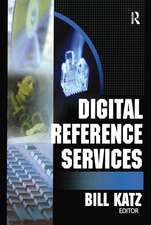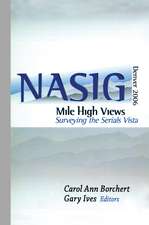Digital Applications for Cultural and Heritage Institutions
Editat de James Hemsley, Vito Cappellini, Gerd Stankeen Limba Engleză Hardback – 28 oct 2005
| Toate formatele și edițiile | Preț | Express |
|---|---|---|
| Paperback (1) | 469.34 lei 6-8 săpt. | |
| Taylor & Francis – 15 noi 2016 | 469.34 lei 6-8 săpt. | |
| Hardback (1) | 1000.27 lei 6-8 săpt. | |
| Taylor & Francis – 28 oct 2005 | 1000.27 lei 6-8 săpt. |
Preț: 1000.27 lei
Preț vechi: 1219.84 lei
-18% Nou
Puncte Express: 1500
Preț estimativ în valută:
191.42€ • 198.64$ • 159.100£
191.42€ • 198.64$ • 159.100£
Carte tipărită la comandă
Livrare economică 15-29 martie
Preluare comenzi: 021 569.72.76
Specificații
ISBN-13: 9780754633594
ISBN-10: 0754633594
Pagini: 334
Dimensiuni: 156 x 234 x 19 mm
Greutate: 0.45 kg
Ediția:1
Editura: Taylor & Francis
Colecția Routledge
Locul publicării:Oxford, United Kingdom
ISBN-10: 0754633594
Pagini: 334
Dimensiuni: 156 x 234 x 19 mm
Greutate: 0.45 kg
Ediția:1
Editura: Taylor & Francis
Colecția Routledge
Locul publicării:Oxford, United Kingdom
Cuprins
Contents: Introduction and international overview, James Hemsley, Vito Cappellini and Gerd Stanke. Part 1 Strategic Developments: DigiCULT: unlocking the value of Europe's cultural heritage sector, Andrea M. Mulrein; Culture as a driving force for research and technology development: a decade's experience of Canada's NRC 3D technology, J. Taylor, J.-A. Beraldin, G. Godin, R. Baribeau, L. Cournoyer, P. Boulanger, M. Rioux and J. Domey; The information society and technology (IST) in Russian culture: strategic review and new initiatives, Nadezda V. Brakker and Leonid A. Kujbyshev. Part 2 Cooperative Projects ArchTerra: an EU project to promote cultural cooperation among Eastern and Western European archaeological communities, Nuccia Negroni Catacchio, Laura Guidetti, Giovanni Meloni and Maurizio Camnasio; CHIMER - a cultural heritage application for 3G environment developed by European children, Romana Krizova; The German-Japanese project for virtual reconstruction of two valuable destroyed buildings, Anne Griepentrog, Alfred Iwainsky and Jan Jordan. Part 3 Recreating and Preserving the Past: German historical buildings in 3D: from cathedral to synagogue and Jewish quarter, Falk Krebs and Edgar Brück: Image -based object reconstruction and visualization for inventory of cultural heritage, Jana Visnovcova, Armin Gruen and Li Zhang; A virtual open air museum in three dimensions in Latvia, Edvins Snore; The virtual Dead Sea Scrolls and the electronic art garden, Susan Hazan; The production of conservation facsimiles: the tomb of Seti I, Adam Lowe. Part 4 Digital Archiving Digital image picture archives: theory and practice in Switzerland, Rudolf Gschwind, Lukas Rosenthaler, Roger Schnider, Franziska Frey and Jeanette Frey; Museum and archive software for the BMW corporate archives , Wolfgang Mueller; The ICCD catalogue's general information system: a tool for knowledge, preservation and valorization national cultural heritage, Maria Luisa Polichetti. Part 5 Design, retrieval and protection The Cleveland special exhibitions tool - an elegant solution to a common requirement, Ben Rubinstein and Holly Witchey; Prometheus: the distributed digital image for research and academic teaching, Sigrid Ruby and Ute Verstegen; HITITE: IST-2000-28484: the heritage illustrated thesaurus: an on-line resource for monument identification, Phil Carlisle; An approach to adding value while recording historic gardens and landscapes (Valhalla), John Counsell; Copyright protection and exploitation of digital cultural heritage, Dimitrios K. Tsolis, George K. Tsolis, Emmanouil G. Karatzas, Dimitrios A Koutsomitropoulos and Theodore S. Papatheodorou; Protection of Inellectual property: a must in digital content exploitation, Jean Barda and Claude Rollin. Part 6 Special Needs: On- line access to cultural and educational resources for disabled people: an international challenge, Marcus Weisen; Web access to cultural heritage for the disabled, Jonathan P. Bowen; Accessible internet applications: principles and guidelines, Beate Schulte and Ulrike Peter; Evaluating websites for accessibility, Brigitte Bornemann-Jeske; Breaking down barriers - electronic aids for non-speaking people, Jochen Scherer. Part 7 Interactive Realities and Future Possibilities: New media art and the contemporary museum environment: a case study based on the NMPFT's award-winning gallery, Malcolm Ferris; MuseumNet: reactivity - a new application metaphor, Alessandro Mecocci; Design of a hand-held interactive support for museum visitors, C. Ciavarella and F Paternò; The impact of Haptic 'touching' technology on cultural applications, Stephen Brewster; The Gulliver project: performers and visitors, Anton Nijholt. Part 8 Conclusions and Future Trends: Conclusions and future trends, James Hemsley,Vito Cappellini and Gerd Stanke; Index.
Notă biografică
James Hemsley has been engaged in pioneering Culture and Technology projects since the mid 1980s. He was the founder of the EVA Conferences and led the pioneering VASARI project. He recently worked with the National Museums of Scotland directing the EC-supported EVA Networking project, EVAN. Vito Cappellini is one of Italy's leading experts in the application of advanced computer and telecommunications technologies to the cultural field and corresponding R&D. He has worked extensively with other major Italian Cultural Institutions. He chairs EVA Florence. Gerd Stanke of GFaI, (a leading Berlin private research institute) is a specialist in image processing including the cultural sector. He has cooperated with many European cultural institutions including the Berlin State Museums (SMB) and chairs EVA Berlin.
Recenzii
'...the broad sweep of the book's coverage, and the many papers featured, serves as a good guide to the range of research being undertaken in this area. It is also refreshing that so many papers are from countries which may be viewed as having fewer resources than the rich West: application of technology for culture and heritage is increasingly achievable for even those with tight budgets.' Journal of Documentation, Vol 63, Issue 3, 2007 'This monograph is highly recommended for academic libraries and museums looking to expand their online presence in dynamic ways' Australian Library Journal February 2007
Descriere
Bringing together leading international practitioners from different disciplines, the EVA (Electronic Imaging and the Visual Arts) conferences help those working in the field to gain the most from developments in multimedia technology. This accessible volume collects recent papers from EVA conferences, covering case studies from the world’s greatest institutions, as well as from some of the smallest and most innovative.

























